LONG-TERM EXHIBITION
Football Museum
The main exhibition of the Football Museum is an engaging and thrilling path through the history of the sport and Brazil. There are fifteen rooms that occupy 6,000 m² and instigate the visitors to experience the sensations and understand why, in Brazil, football is more than a sport: it is our heritage, part of our culture and our identity.
This exhibition was on view until November 6, 2023. Discover our new main exhibition.
From September 29th, 2008 to November 6th, 2023
Directions
Click here to access different transport options.
Penalty Area Room and King Pelé reception
The tour starts in the Penalty Area Room, a huge gallery where the visitors find a collection with hundreds of reproductions of objects that allude to our affective memory of football: pins, buttons, banners, toys, stamps, stickers, postcards… the diversity of items makes us travel in time and recall the living room of our grandparents or child’s games. In these walls, there are several references to Brazilian stars and teams. Try to find them! And don’t forget to look up: the Penalty Area Room is the best place in the museum to view the underside of the bleachers in Pacaembu Stadium.
When the visitors go up the stairs that lead to the first floor, they are welcomed by King Pelé, the most popular football player in the planet.
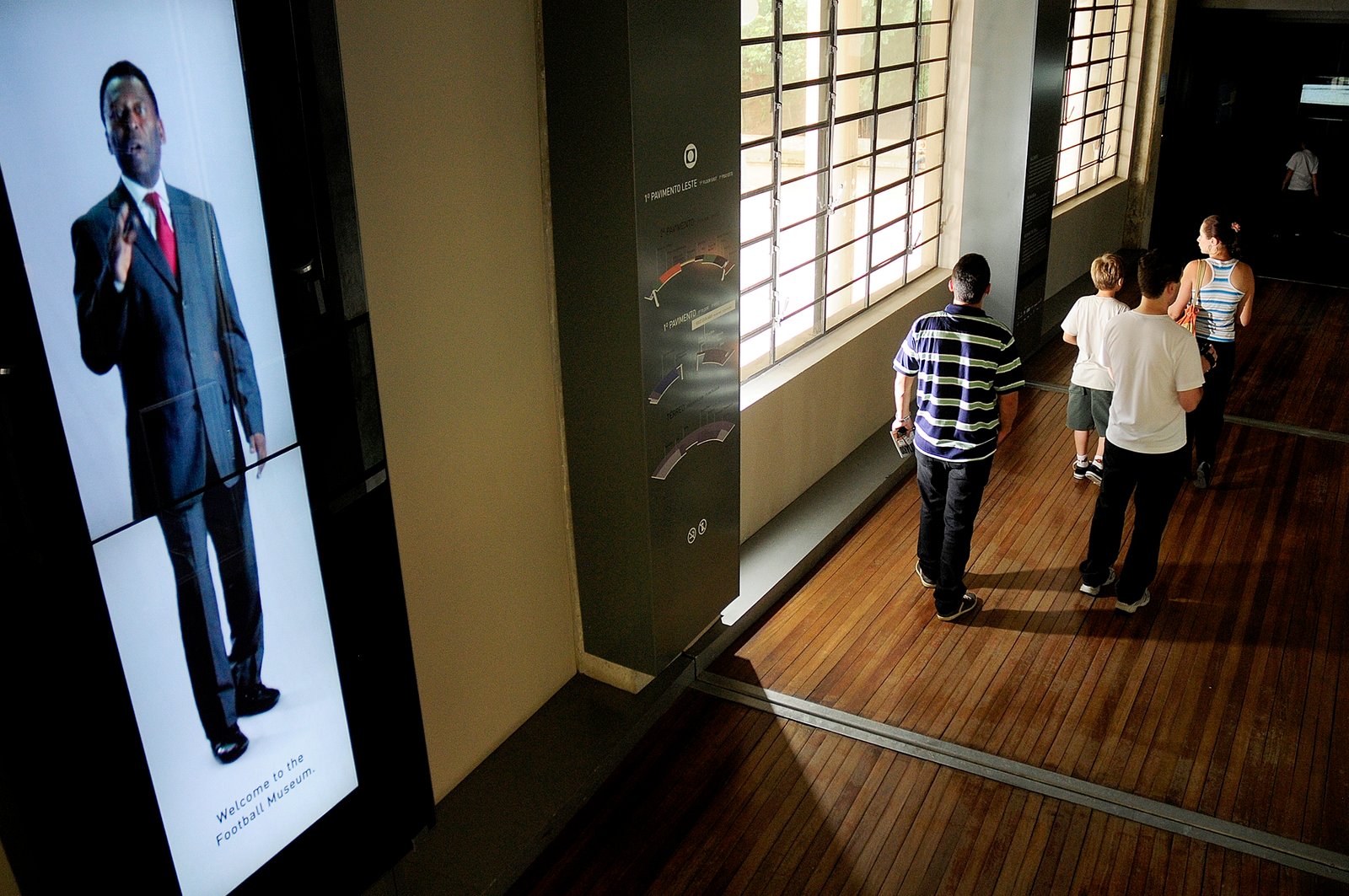
Baroque Angels, Goals, and Radios Rooms
Children of the whole world play football, not matter in which conditions: on the streets, at the beach, in their neighborhood, on grass, wearing boots, slippers, or barefoot. In the Foot on the Ball Room, the visitors are guided to the next environment by the feet of the children.
The Baroque Angels Room creates the ethereal dimension of the idols who helped building the history of Brazilian football. As if they floated in space, followed by the sound of atabaques, 27 players from all eras are honored. Among them, Julinho Botelho, Didi, Zagallo, and Gilmar. Since 2015, the Football Museum also included great Brazilian women footballers: Marta, Formiga, Sissi, and Cristiane Rozeira are also among the baroque angels.
Then, the Goals Room displays great remarkable plays, selected by Brazilian sports announcers and personalities – there are 10 interactive booths, where the visitors can choose the play they want to watch. Right next to this room, the Radio Room celebrates the announcers and media outlet that brought football to the entire national territory, still in the 1930s. There are 9 interactive booths in which visitors can choose sections of narrations to listen to and follow on screen.
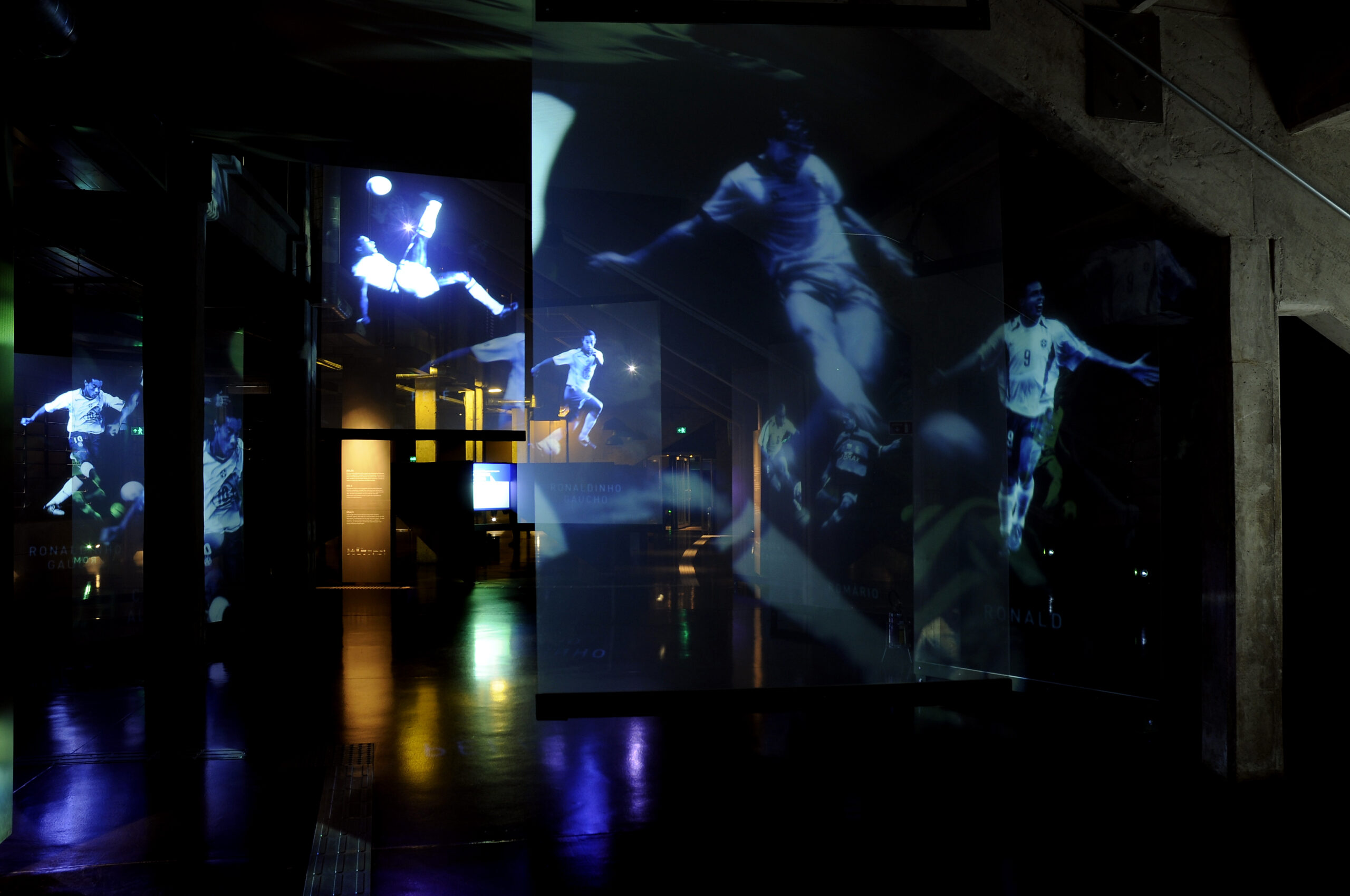
Exaltation Room
In the transition from the first to the second floor of the Football Museum, the visitors have the unique opportunity to see the bowels of a football stadium. The Exaltation Room was created from an opening in a crossing, which did not exist before, leading to a sort of cave formed by the bleacher support pillars and the hill on which the sides of the Pacaembu stadium lies. Among the pillars, images of Brazilian club fans are projected, with the loud sound of their battle cries: it is as if the visitor is taken right to a football match.
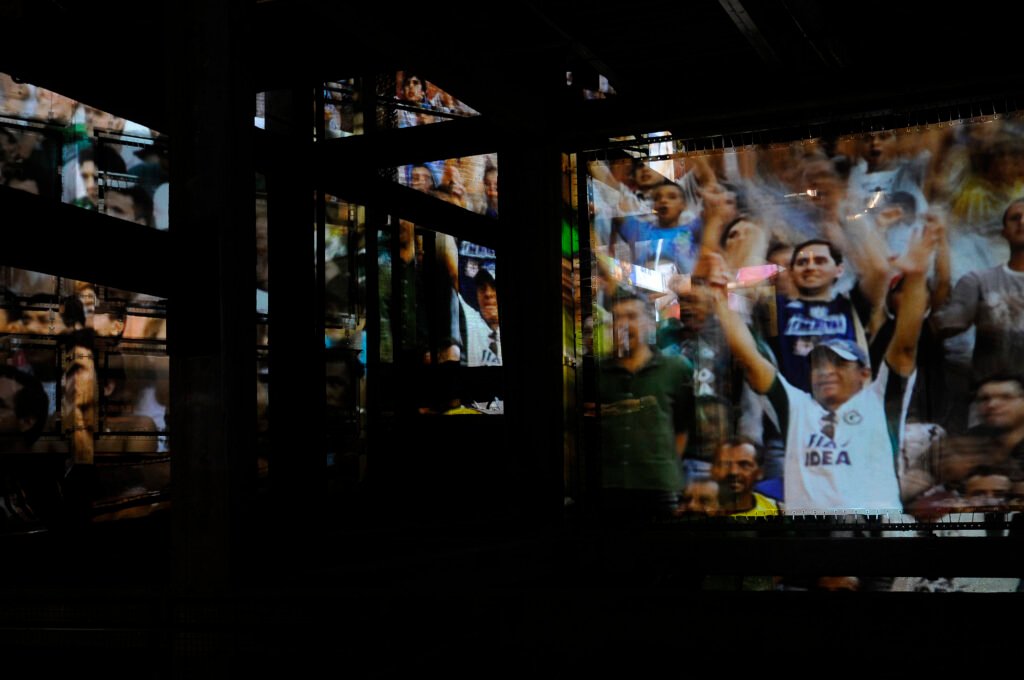
Origins Room
On the second floor, the exhibition displays its historic axis. A sequence of rooms introduces the visitors to the arrival of football in Brazil and how it became the main and most popular sport: the Origins Room displays pictures from the end of the 19th century up to the middle of the 1930s. A stimulating scenario that places us in the urban Brazil of the beginning of the 20th century, when football was still amateur and played, in clubs, only by the white elite. However, in factory floors, streets, and popular neighborhoods, the people, hard-working, poor, and mestizo, also played the game and seriously contested their right to play football. Professionalism also marked the amalgamation of the sport that would become, decades later, the face of Brazil.
Except for women… since 2015, the Football Museum displays, in the same Origins Room, how the path of women did not have the same outcome as the path of men. Women’s part in the game also dates from the end of the 19th century in European countries, such as United Kingdom, France, and Spain, and the beginning of the 20th century in Brazil. Even though here they played in different locations from men, such as circuses, there is evidence of an ever-growing female presence, however brutally interrupted in 1941, when a Decree Law issued by the dictatorial government of Getúlio Vargas prohibited women to practice sports.
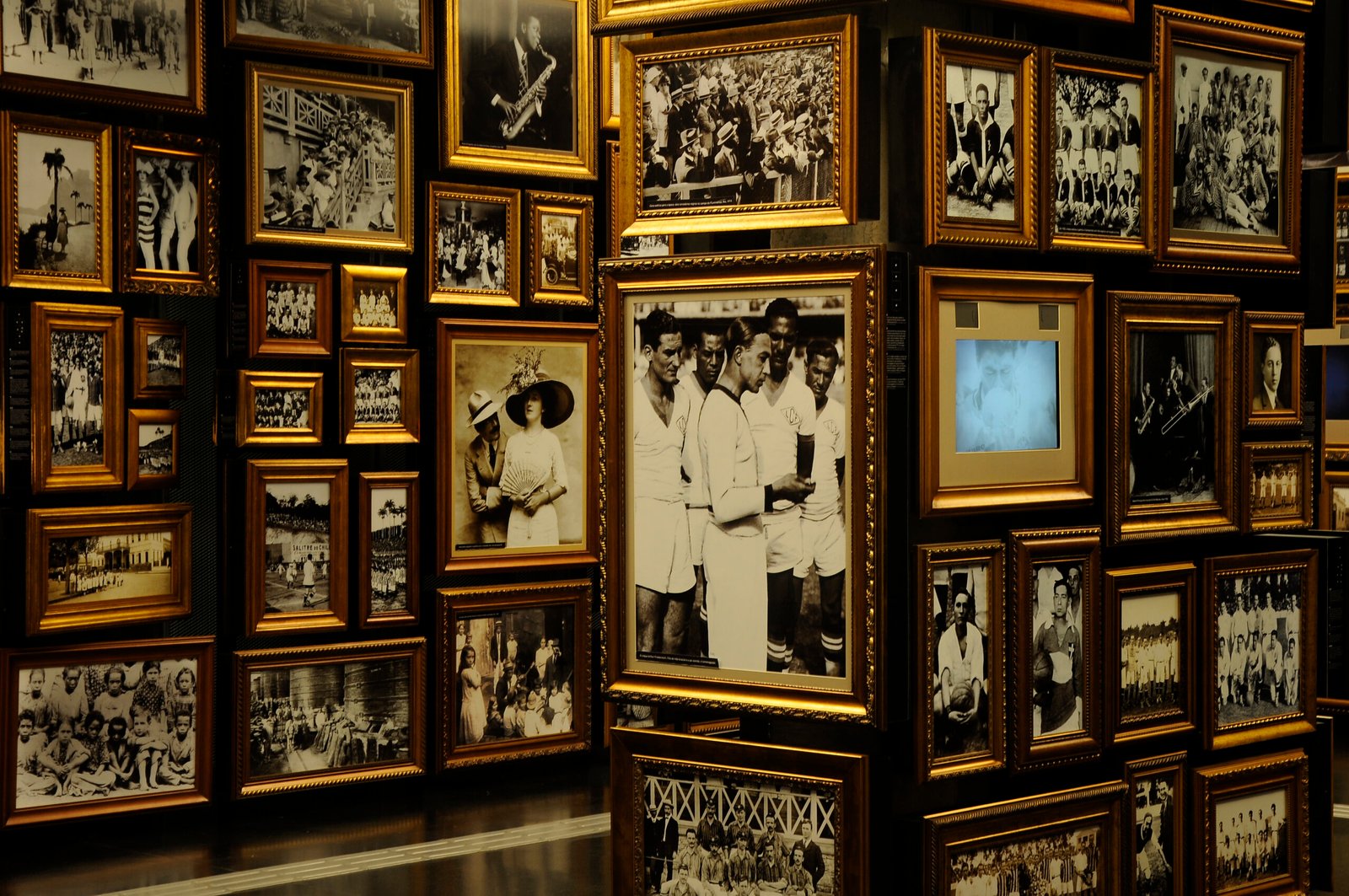
Heroes and Rite of Passage Rooms
In the Heroes Room, the visitors understand how, in the 1930s and 1940s, an idea of Brazil is created that introduces to the world our most unique feature: cultural and racial crossbreeding, present in music, visual arts, dancing, cuisine, and also in football. There are 20 personalities, among them poets such as Carlos Drumond de Andrade, artists such as Tarsila do Amaral, and intellectuals such as Sergio Buarque de Hollanda and Gilberto Freyre. Leônidas da Silva and Domingos da Guia, black players who shined in the history of football, are also honored.
The Rite of Passage Room marks a shift in the journey. A dramatic pause to relive the trauma of losing World Cup 1950. In a crowded Maracanã stadium, built in less than 2 years to host the first edition of the World Cup after World War II, Brazil cried to see the national team lose to the Uruguayans. Our football was never the same after this episode.
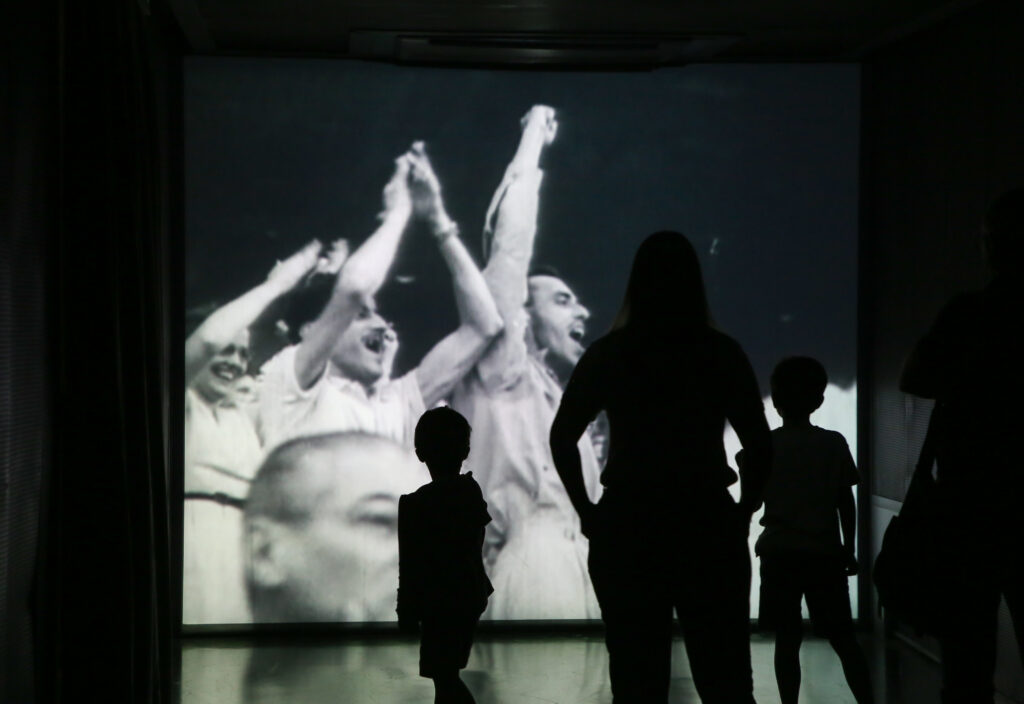
World Cups and Pelé and Garrincha Rooms, and Broadcaster Pedro Luiz Walkway
The World Cups Room displays the glories of five world championships won and participation in all twenty editions of the greatest sports spectacle in the world. The defeat and shame of the “7×1” against Germany is also there, so that we never forget that football has changed, once again. Pelé and Garrincha highlight the greatness of Brazilian football in the decades of 1960 to 1970. They never lost a match when playing together. Their styles and journeys are as distinct as they are brilliant, and got a room dedicated to the joy of “art-football”. Between both environments, the Football Museum displays one of its most important items: the jersey Pelé wore on the final against Italy in World Cup 1970.
In the Broadcaster Pedro Luiz Walkway, a break to contemplate the charming Pacaembu neighborhood, under governmental trust due to its unique urban plan in the Capital.
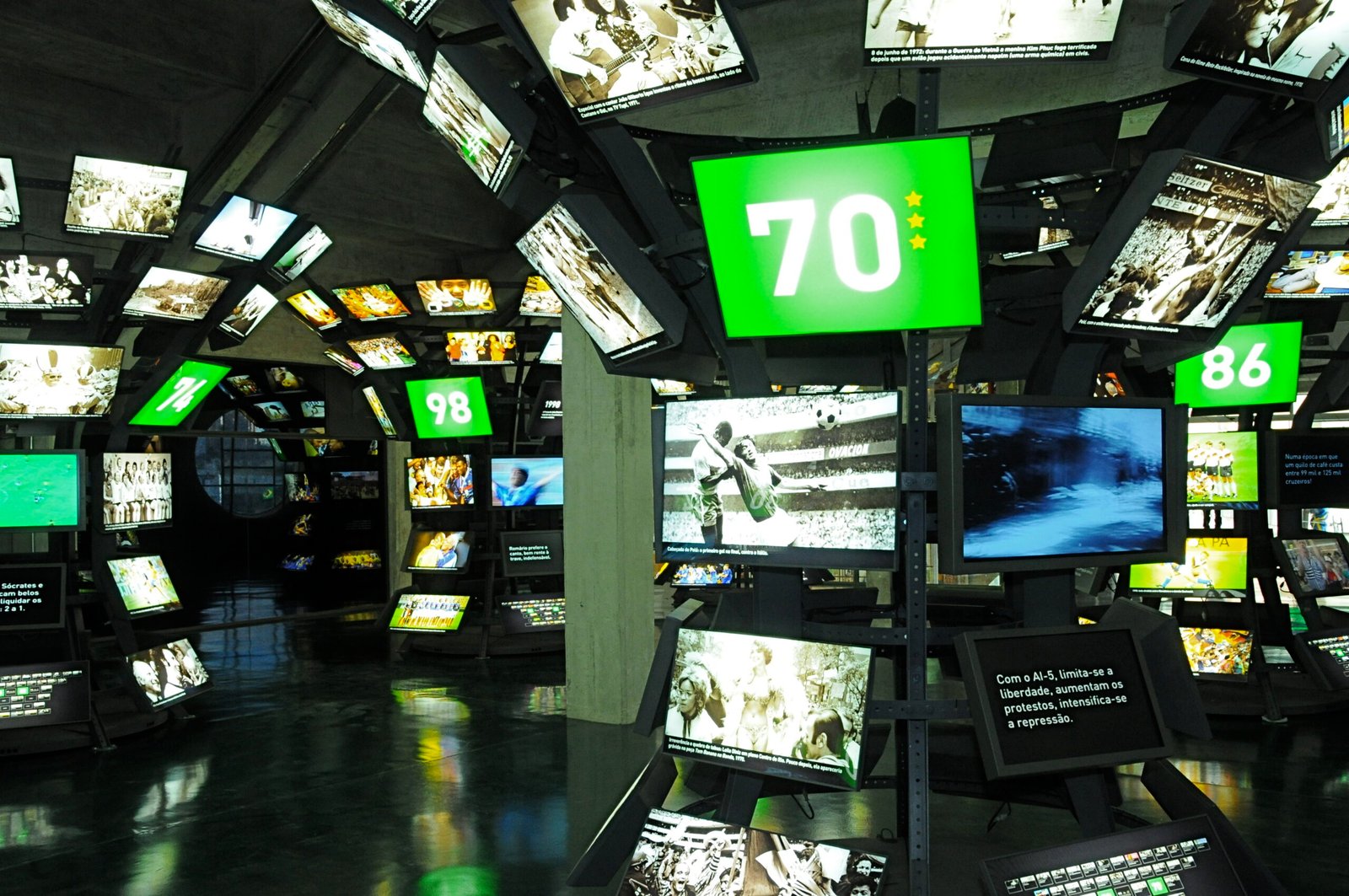
Figures and Trivia, Dance and Body Game Rooms
There is a lot of fun in the Figures and Trivia, with gigantic signs that tell rules, records, and funny quotes of the history of football. Five foosball (or table football) tables teach tactics. When visiting the bleachers, the audience can also dazzle at the beautiful field of the stadium.
The Dance of Football Room shows wonderful movies for those who love to relive spectacular plays: Dribbles, Goals, and Saves. Canal 100, a newsreels that became a landmark due to its way of filming matches, is also highlighted. And, since 2015, three movies display important achievements and struggles of women in football: “Pioneiras”, “Jogo Bonito”, and “Campeonatos”.
The last section of the long-term exhibition includes the Body Game Room, with activities in the virtual field and “Goal Kick”, and the Homage to Pacaembu Room, imperative for those who love architecture and photography.
Visiting booklet for foreigners
Gallery
Technical file
CREATION AND DEVELOPMENT
Hugo Barreto
General Project Coordination
Lucia Basto
Jarbas Mantovani
Curatorship
Leonel Kaz
Architecture
Mauro Munhoz
Museography
Daniela Thomas
Felipe Tassara
Multimedia and Visual Identity Art Direction
Jair de Souza
MUSEUM PRODUCTION
Tecnology
Peter Lindquist
Gilberto Nicola Bernardo
Content Consultancy
João Máximo
Celso Unzelte
Marcelo Duarte
Marcos Duarte
Roberto DaMatta
Turíbio Leite de Barros
Research
Antonio Venancio
Duda Magalhães
Fernanda Terra
Vladimir Saccheta
Content Produtcion Coordination
Gisela Pedroso
Production Management
Engineering S.A.
Eduardo Spinazzola
Expo-Graphic Executive Design
Anexo Comunicações
Marcia Moon
Iara Terzi Ito
Tania Mara Menecucci
Visual Communication Executive Design
Vinte Zero Um Design
Rita Sepúlveda
Ana Carolina Montenegro
Museological Project
Marcelo Mattos Araújo
Maria Cristina Oliveira Bruno
Lighting
LD Studio
Sound
Audium Engenharia
José Dionísio Neto
Acoustics
Passeri Arquitetos Associados
Lineu Passeri
Façade Restoration Project
Wallace Caldas
INTERNAL ADAPTATION
Project and Construction Management
Engineering S.A.
Sergio Falcão
Richard Gentil
Flávio Matsumoto
Marcia Alonso
Sérgio Munin
Architectural Project Development
Mauro Munhoz Arquitetura
Daniel Pollara
Paula Bartorelli
Technical Project Compatibilization
Eloíse Amado
FUNDAÇÃO ROBERTO MARINHO
TECHNICAL TEAM
Executive Superintendent
Nelson Savioli
Project Coordination
Claudia Coutinho
Larissa Torres Graça
Relation with Partners and Press Office
Ricardo Piquet
Hugo Sukman
Legal Administration and Support
Carlos Carletto
Cláudio Lins de Vasconcellos
Gustavo Bastos
Luís Henrique Cordeiro
The Football Museum was instituted by a municipal law written by councilman Antonio Goulart.


